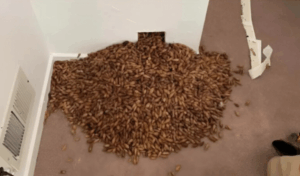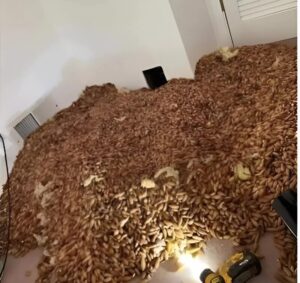I had always thought of my house as a quiet companion. Its voice was the steady tick of a clock, the occasional groan of old floorboards—nothing more. But one winter, that familiar stillness began to splinter. At first, it was subtle: a faint tapping, a soft shuffle, a muted thump deep within the walls. I told myself it was just pipes, or wood settling the way old houses do. But the sounds kept coming, more deliberate, more rhythmic—almost as if the house itself held a secret heartbeat.

Lying awake at night, I sometimes swore the walls were breathing. It wasn’t wind, nor rain—it felt alive. I dismissed it as stress or fatigue playing tricks on me, but soon shadows began to ripple in strange places, moving where no light should fall.
Curiosity replaced fear at first. I wanted to believe it was nothing. But curiosity has a way of shifting into unease, and before long, I was straining to hear every whisper in the dark, wondering what lived alongside me.

The truth revealed itself one gray afternoon, when I noticed a faint dripping in the ceiling. My first thought was a leak, my second—pests. Neither comforting. I called pest control, expecting a quick answer. The inspector listened to the walls, frowned, and told me we’d need to open them up.
I braced for the worst—termites, rodents, mold. He made a careful cut into the drywall, and then something extraordinary happened.
From the opening poured a cascade of acorns.
Not a handful, not even dozens—but thousands. They tumbled across the floor in a wave, warm and earthy, rolling like marbles across the wood. For a moment we stood frozen, as though the house itself had decided to spill its secrets.

Inside the walls, packed tightly from floor to ceiling, were layers upon layers of acorns—over seven hundred pounds in total. The inspector shook his head in awe. He’d seen infestations, decay, destruction… but never this.
The culprit wasn’t a rodent, or even a squirrel. It was a bird: the Acorn Woodpecker. Patiently, for years, it had slipped through tiny gaps in the eaves, stashing acorn after acorn, building its winter pantry with meticulous care.
I should have been angry. Repairs would be costly, and my walls had been turned into a granary. But as I stood there, staring at the mountain of acorns, I felt something else entirely. This wasn’t damage—it was devotion. A creature’s survival plan, carried out with tireless dedication.
I remembered those restless nights, when I thought the house itself was breathing. All that time, the bird had been at work, ferrying seeds one by one, guided by instinct and foresight. I had feared the unknown—but the unknown had been nothing more than a neighbor trying to endure the winter.
We gathered the acorns carefully, bagging them until the room looked like a forest market. I couldn’t throw them away. Instead, we carried them to the edge of the woods, where deer, squirrels, and other birds could feast.
When the repairs were finished, the house looked unchanged. But to me, it felt transformed. It had offered me a gift: a reminder that even the smallest lives carry wisdom. That patience, resourcefulness, and persistence aren’t human virtues alone—they belong to nature too.

Now, when the wind sighs against the siding, I pause to listen. Perhaps it’s the same woodpecker, seeking another hollow to fill. Or maybe it’s another bird continuing the ritual. Either way, I no longer dismiss the sounds.
When people ask about the “mystery in my walls,” I tell them the story—not the technical details, but the heart of it. That for a time, my house was shared. That what I thought was intrusion turned out to be a lesson.
Because sometimes, the oddest disturbances aren’t warnings to fear. They’re invitations to notice.
And whenever I remember that river of acorns spilling across the floor, I smile. The house may be mine—but for a while, it belonged to a small, determined bird who taught me the quiet art of preparation.


